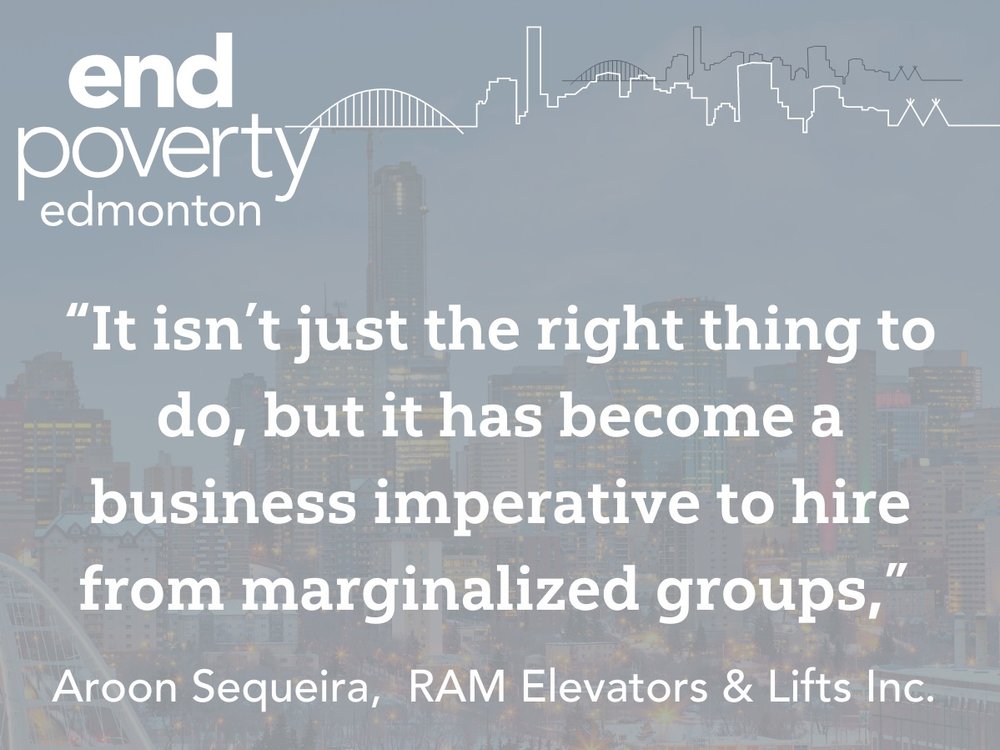How do you make an inclusive economy that benefits everyone, when the process of connecting workers to jobs and jobs to workers isn't streamlined, clear or even fair for all?
EndPovertyEdmonton strives to build an inclusive economy that supports marginalized communities such as women, Indigenous peoples, people with disabilities, newcomers and all those living in poverty. However, the road to an inclusive economy is anything but straight and smooth. The road has numerous unmarked turnoffs, leaving people looking for work and employers on their own to navigate through trial and error. The road is also littered with potholes: systemic barriers like racism, sexism, and ableism, are coupled with lack of training, competition and government policies that hinder rather than help.
Currently, there are over 35 workforce organizations in the city providing employment support in workforce development. The employment support community is robust, with many organizations providing employment related supports to marginalized communities. However due to funding, policies and other systems level barriers, there is often little room for coordination or collaboration.
“We've heard from employers that it is very confusing to know which of these over 30 organizations they should be working with to get the right supports,” says Brooks Hanewich, Manager of Strategic Initiatives with EndPovertyEdmonton. “In addition, when employers are seeking employees and are interested in diversifying their workforce, they also don't know where to start.”
Some of these organizations that provide employment support for people that face barriers include Women Building Futures, Careers the Next Generation, and Indigenous and newcomer workforce organizations. In the current system, these groups struggle to effectively collaborate and there are systemic barriers that keep them from being able to have significant impact.
That's where the Workforce Development Collaboratives come in. These two groups of employment support organizations have spent the last year coming together to identify pitfalls within the employment and workforce system, and nurturing collaboration - so both workers and employers can more easily find each other.
EndPovertyEdmonton has spent the last year, bringing these workforce development organizations together, with employers at the table, all in one space building and creating a more solid, sustainable and effective workplace ecosystem where everyone from job seekers to employers gets what they need.
And more and more they're finding that there is a new growing crop of business leaders interested in diversifying their workforce, desperate to connect with the strong infrastructure of Alberta's employment organizations. That's good news!
“So we started to gather organizations to see if they would be interested in meeting, and the response was overwhelmingly positive,” says Brooks Hanewich.
Currently, there are two different workforce development collaborations taking place - the ethno/cultural group that started over a year ago, and the Indigenous group that has been meeting for the past six months.
Within these conversations, collaborative members seek to better understand the systemic barriers to employment, and look for ways to effectively address them. For example, one of the barriers they've discovered is, current funding systems foster competition, not collaboration, and some of the organizations receive funding for similar programs. Research shows its funding models that are reinforcing program success - meaning funding is renewed for organizations who meet their targeted objectives. Securing funding becomes the goal. Because each agency has different definitions and measurements of success, it becomes difficult for the collaborative to measure overall outcomes of success at a systems level.
The end result is a workplace ecosystem that disincentivizes workforce development groups from working collaboratively. This creates a system of silos making it harder for job seekers to easily find employment, and for workforce development groups to even know about or offer options or alternatives.
Then there are the employers.
“We also brought in employers to the workforce collaboration groups,” says Brooks Hanewich. “We wanted to see how it works in real-time, and we can see the gap when we get these organizations and employers together. They tell us it is complicated and needs improvement.”
This collaborative work strips down the employment system to examine it piece by piece from both sides of the hiring line - to uncover where it is working and where it isn't. Then using that data and information, the workforce collaboratives in consultation with the community, finds actionable ways to repair the system so it works for all.
“Until we think through how the system is structured, the incentives in it and examine those pieces we won't be able to make a broader impact on the larger kind of employment landscape for Alberta,” explains Hanewich.
Tightening that workforce development system even further is one of the recommendations of the Business Council of Alberta. The Business Council of Alberta actively seeks industry-led policy change by government. Like EndPovertyEdmonton, it too recognizes that accessing programs is a major consideration for addressing long-term unemployment in Alberta. One of its recommendations suggests that the governments of Alberta and Canada fund a single, clear, accessible one-stop window, administered by one non-profit organization, to help individuals, businesses, and community organizations access government and third-party supports for upskilling and training programs. (Feb. 2022 Task Force Final Report | Clearing a Path: Helping Displaced Albertans Re-Enter the Workforce)
Essentially this is also the goal of the workforce development collaborative. While it may not be creating one organization - they are attempting to streamline support.
Mike Holden, with the Business Council of Alberta says, "One of the things that needs to change is making sure that businesses have easier access to people who have the skills that they're looking for and then retraining and making sure that people are aware of the opportunities that are out there, and are able to easily and inexpensively access the skills training that they need to be able to get to these jobs."
Zane Hamm is the Inclusion and Community Engagement Specialist at Women Building Futures, which offers women employment training, support services, readiness workshops and affordable housing to help women enter the trades and find meaningful employment with liveable incomes.
Hamm, through Women Building Futures, has been participating in the workforce development collaborative that EndPovertyEdmonton is conducting.
“Being able to connect with organizations and collaborate on ideas on how to improve employment service delivery has been a great benefit to us,” explains Hamm. “I try to enhance collaboration, share resources, make sure that we're not duplicating services, and that other groups know about Women Building Futures and we know about them.”
You also can't address employment barriers for marginalized communities without recognizing that racism, sexism, colonialism and ableism are all deeply entrenched in our employment system and society in general. These barriers to employment are also addressed within the workforce development collaborative and in every area of EndPovertyEdmonton's work.
Karen Bruno is the Indigenous Community Engagement Manager with EndPovertyEdmonton and works on the Indigenous workforce development collaborative.
“Some of the agencies are trying to come up with creative ways for training and being better community allies. And construction companies are seeing how they can adapt and provide better training around racism within their own organizations, says Karen Bruno.”
Hamm agrees, “We want to ensure that the employers are committed to the same goals and understanding the needs of the members and commitment to economic security. I think that bringing into the conversations with employers the importance of mentorship and sharing stories across the generations so that we really understand what have been some of the barriers and challenges and how those have been overcome, is important.”
Aroon Sequeira is the chair of RAM Elevators & Lifts Inc. and is on the board of the Business Council of Alberta.
“On the business side we've gone through decades where the fight was always to retain clients and customers. If we landed great customers we'd always have employees who could look after them. That's not the case anymore. Now there is an abundance of work, and today the companies that will succeed are the ones that can attract and retain employees. But it's always been a diversity first approach and inclusion second. But while diversity speaks to attraction - inclusion speaks to retention. And retention is the big challenge for employers right now.”

Sequeira says there is a huge opportunity for EndPovertyEdmonton to move the needle in building an inclusive economy. Because of that severe shortage of talent, employers are going to be looking desperately to the untapped labour markets of the past - those who have been marginalized and continue to be. There's now a huge incentive for employers to hire from these groups.
Ram Elevators and Lifts has made it a priority to hire from marginalized groups and has been working with a workforce development organization to find good employees to fill their labour shortages.
“It isn't just the right thing to do, but it has become a business imperative to hire from marginalized groups,” he adds.
But while the economic conditions may be ripe for getting more marginalized people out of unemployment - the job of the workforce collaborative remains to streamline the connection between workers and work. Together they are taking positive steps and collaborating. Two organizations, for example, recently put in a joint employment funding proposal.
“Everybody's really good at what they do, they all have their different levels of skills and diverse populations of people they work with, and it didn't take long for us to turn into an action-oriented circle,” says Karen Bruno. “We come to the table having conversations, building respectful relationships with each other, and looking for ways to reduce gaps in economic opportunity.”
EndPovertyEdmonton has been able to earn the trust of these organizations - bringing them together as a connector with a panoramic view of the entire workforce ecosystem, to generate excitement, new hope, and perspective - all essential tools to help grow and ensure our economy is more inclusive.
“There's power in connection, but also a united voice and united efforts in offering that there's that value place, the commitment to safe, respectful and diverse workplaces,” says Hamm. “Someone like Brooks at EndPovertyEdmonton has the understanding from the community organizations about the importance of sustained work.”
“I don't think we have to reinvent anything new,” reflects Hanewich who's spent 17 years in workforce development. “I think all the pieces actually exist, it's more how do you utilize them in a really strong way? So we are working on it effectively and things are moving forward. And the more companies in our communities start to know that these resources exist now, that's a win. Because then they think they can tap into some of these organizations to find really good workers and hopefully provide them meaningful work in an inclusive economy.”
For more information on the workforce development collaboratives contact Brooks Hanewich at bhanewich@endpovertyedmonton.ca

